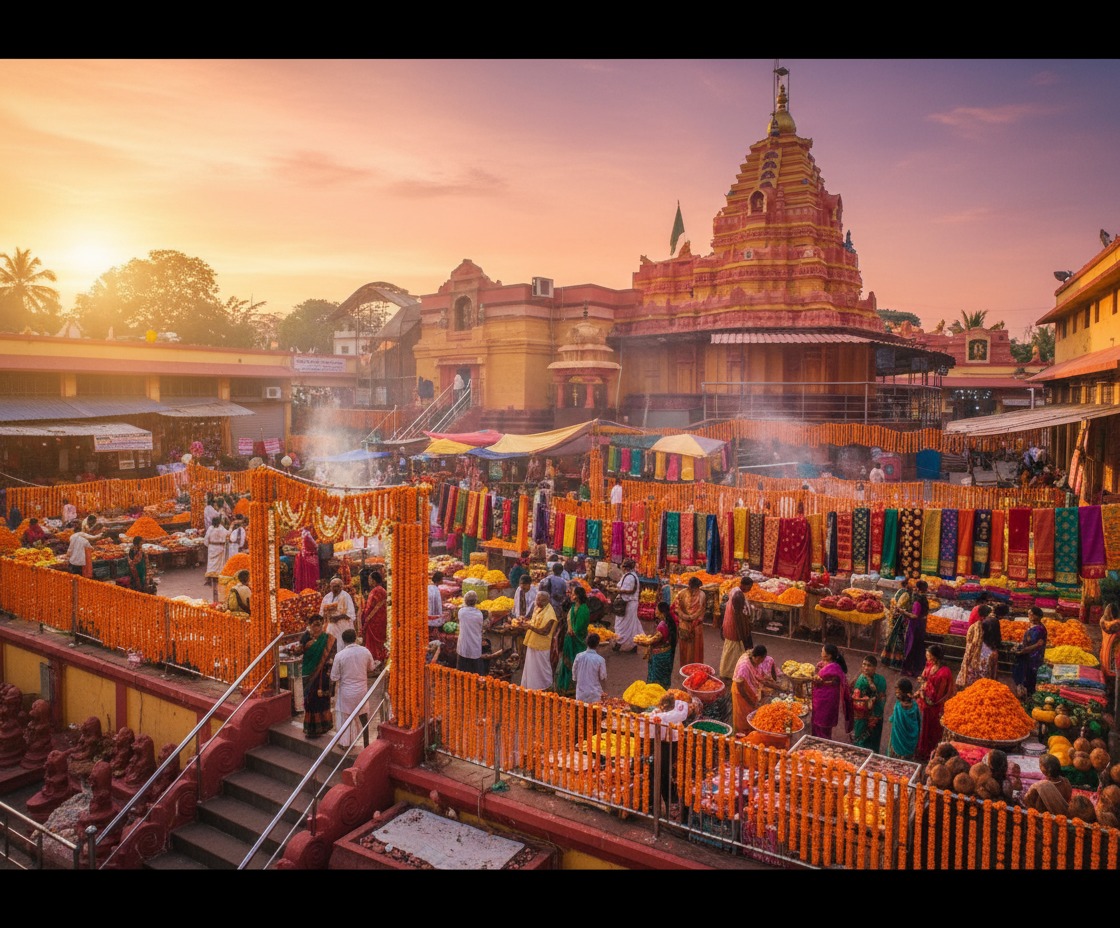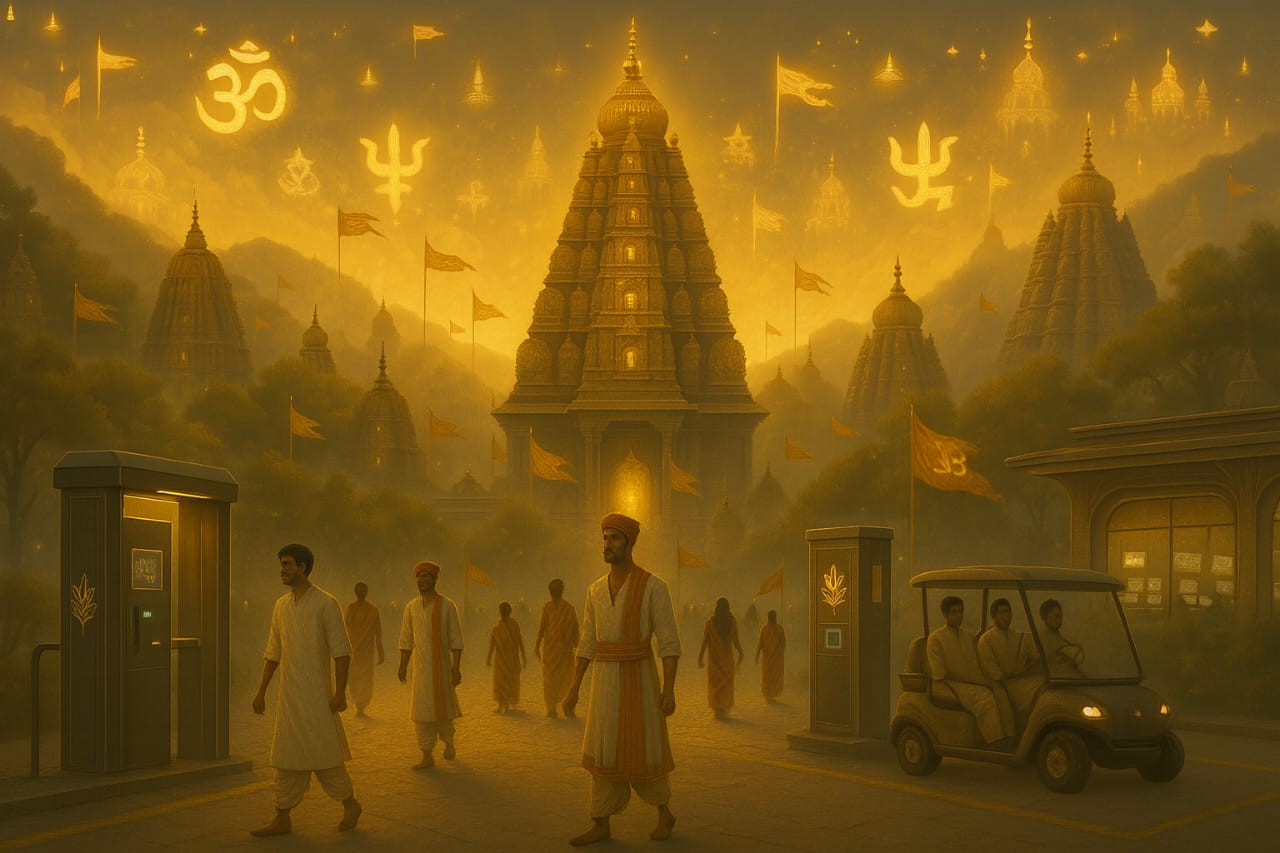Introduction
The Saundatti Yellamma Temple stands as one of Karnataka’s most revered spiritual destinations, drawing millions of devotees each year. Dedicated to Goddess Yellamma (Renuka Devi), this ancient temple and its famous Jatra festival embody a powerful blend of devotion, tradition, and cultural heritage.
Whether you’re a spiritual seeker, cultural enthusiast, or first-time visitor, this guide will take you through the temple’s sacred origins, the grand Jatra festival, and how modern solutions are reshaping the pilgrimage experience.
Historical Origins and Sacred Foundations of Saundatti Yellamma Temple

The Sacred Land of Saundatti
Nestled in northern Karnataka, amid the rugged hills of the Malaprabha River basin, lies the ancient town of Saundatti. Known historically as Sugandavarti and later as Savadatti, the town has long been a center of spirituality, commerce, and culture. At its heart stands the Sri Renuka Yellamma Devi Temple, one of South India’s most significant pilgrimage sites.
Every year, devotees from Karnataka, Maharashtra, Goa, Andhra Pradesh, and Telangana flock here to seek the goddess’s blessings. The Yellamma Jatra, the most significant of these fairs, draws a staggering 1–1.25 crore pilgrims every year, making it one of South India’s largest gatherings of faith.
Who is Goddess Yellamma?
Renuka, wife of Jamadagni Maharshi and mother of Parashurama, the sixth avatar of Lord Vishnu, is worshipped as Yellamma, the universal mother. She embodies chastity, sacrifice, and resilience.
Legends tell of her abandonment, curse, and eventual rebirth as Yellamma, a transformation that made her a symbol of forgiveness and divine motherhood. The Renuka Tirtha, a sacred water tank near the temple, is believed to wash away sins, drawing pilgrims in search of spiritual liberation.

The Grand Yellamma Jatra Festival Experience
Held during the full moon day of Pausha month (December–January), the Jatra is one of India’s largest religious gatherings. The timing follows the harvest season, allowing farmers and families to participate in full devotion.
Over 800,000 pilgrims converge on Saundatti during the main three days of celebration, carrying saffron and red flags as they walk, ride bullock carts, or travel by buses to the temple. Folk music, chanting, and rituals create an electrifying atmosphere of faith.
Yet, the sheer scale also strains local infrastructure. Parking chaos, long walks, and limited amenities have historically tested both devotees and administrators.
Cultural and Economic Impact
The temple and Jatra are not only spiritual landmarks but also cultural powerhouses. The temple remains a cultural heartbeat where Yellamma Geethe folk songs are sung, Jogati and Devadasi dances are performed, and artisans keep traditional crafts thriving These practices preserve Karnataka’s ancient heritage while uniting communities in devotion.
Economically, the Jatra is the lifeline of Saundatti. Local vendors, food stalls, lodges, and transport services earn a large portion of their yearly income during this period. Families open homes for pilgrims, while farmers supply grains and dairy to meet the massive demand. This annual festival sustains livelihoods across the region.
The Challenges of the Jatra (Before 2025)
For decades, the grandeur of the Jatra was overshadowed by chaos and mismanagement:
Traffic jams stretching 5–10 km.
Unplanned parking clogging highways and village roads.
Poor sanitation and health risks from inadequate toilets and water.
Law and order concerns, with police struggling to manage lakhs of devotees manually.
Revenue loss, as authorities lacked structured ticketing and amenities management.
For many, the journey of faith became one of exhaustion and inconvenience, dampening the spiritual essence of the festival.
Transformation with Smart Solutions
The turning point came in 2025, when Saundatti adopted the Zagoo Smart Parking Ecosystem. This pioneering system introduced:
ANPR cameras & digital valet services.
Pre-booking of parking slots.
Shuttle buses from parking to the temple.
Bio-toilets, dormitories, and refreshment centers.
Digital dashboards for real-time monitoring.
For the first time, devotees experienced smooth traffic flow and organized facilities. Pilgrims reached the temple in minutes instead of hours, police could focus on safety rather than manual traffic control, and vendors benefited as visitors arrived stress-free and spent more time in town.
A Symbol of Faith and Innovation
The 2025 Yellamma Jatra was not just a festival—it became a global case study of how tradition and technology can walk hand in hand. Devotees worshipped with dignity, authorities managed with ease, and Saundatti transformed into a model for future pilgrimage towns.
As one elderly devotee from Belagavi reflected:
This went beyond smart parking – it symbolized a new way of living where faith and technology walk hand in hand. For the first time, I saw faith and technology together
Conclusion
The Saundatti Yellamma Temple remains a living symbol of devotion, heritage, and resilience. Its thousand-year-old legacy continues to inspire millions, while the Yellamma Jatra stands as one of India’s most extraordinary spiritual gatherings.
Thanks to modern solutions, what was once a festival of chaos is now a celebration of faith, order, and dignity.
✨ The legacy of Yellamma teaches us that faith is eternal – and with innovation, it can thrive in harmony with the modern world.
Ready to Transform Your Pilgrimage Town?
Just like Saundatti, your city or facility can benefit from the Zagoo Smart Parking Ecosystem.
Let’s make your next event a success story.
